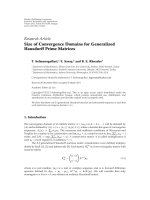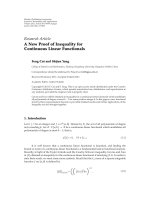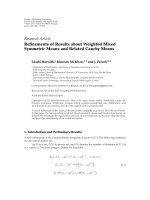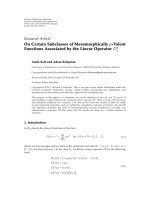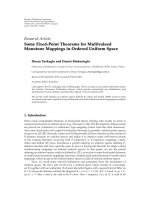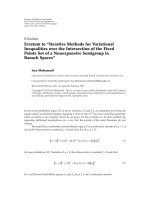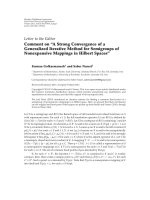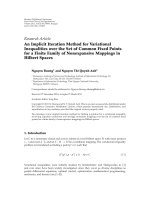Hindawi Publishing Corporation Fixed Point Theory and Applications Volume 2011, Article ID 274820, docx
Bạn đang xem bản rút gọn của tài liệu. Xem và tải ngay bản đầy đủ của tài liệu tại đây (530.41 KB, 19 trang )
Hindawi Publishing Corporation
Fixed Point Theory and Applications
Volume 2011, Article ID 274820, 19 pages
doi:10.1155/2011/274820
Research Article
Hybrid Algorithm for Finding Common
Elements of the Set of Generalized Equilibrium
Problems and the Set of Fixed Point Problems of
Strictly Pseudocontractive Mapping
Atid Kangtunyakarn
Department of Mathematics, Faculty of Science, King Mongkut’s Institute of Technology Ladkrabang,
Bangkok 10520, Thailand
Correspondence should be addressed to Atid Kangtunyakarn,
Received 8 November 2010; Accepted 14 December 2010
Academic Editor: Qamrul Hasan Ansari
Copyright q 2011 Atid Kangtunyakarn. This is an open access article distributed under the
Creative Commons Attribution License, which permits unrestricted use, distribution, and
reproduction in any medium, provided the original work is properly cited.
The purpose of this paper is to prove the strong convergence theorem for finding a common
element of the set of fixed point problems of strictly pseudocontractive mapping in Hilbert spaces
and two sets of generalized equilibrium problems by using the hybrid method.
1. Introduction
Let C be a closed convex subset of a real Hilbert space H,andletF : C × C → R be
a bifunction. Recall that the equilibrium problem for a bifunction F is to find x ∈ C such that
F
x, y
≥ 0, ∀y ∈ C. 1.1
The set of solutions of 1.1 is denoted by EPF. Given a mapping T : C → H,letFx, y
Tx,y − x for all x, y ∈ C. Then, z ∈ EPF if and only if Tz,y − z≥0 for all y ∈ C;
that is, z is a solution of the variational inequality. Let A : C → H be a nonlinear mapping.
The variational inequality problem is to find a u ∈ C such that
v − u, Au
≥ 0
1.2
2 Fixed Point Theory and Applications
for all v ∈ C. The set of solutions of the variational inequality is denoted by VIC, A.Now,
we consider the following generalized equilibrium problem:
Find z ∈ C such that F
z, y
Az, y − z
≥ 0, ∀y ∈ C. 1.3
The set of z ∈ C is denoted by EPF, A,thatis,
EP
F, A
z ∈ C : F
z, y
Az, y − z
≥ 0, ∀y ∈ C
. 1.4
In the case of A ≡ 0, EPF, A is denoted by EPF. In the case of F ≡ 0, EPF, A is also
denoted by VIC, A. Numerous problems in physics, optimization, variational inequalities,
minimax problems, the Nash equilibrium problem in noncooperative games, and economics
are reduced to find a solution of 1.3; see, for instance, 1–3.
A mapping A of C into H is called inverse strongly monotone mapping,see4, if there
exists a positive real number α such that
x − y, Ax − Ay≥α
Ax − Ay
2
1.5
for all x, y ∈ C. The following definition is well known.
Definition 1.1. A mapping T : C → C is said to be a κ-strict pseudocontraction if there exists
κ ∈ 0, 1 such that
Tx − Ty
2
≤
x − y
2
κ
I − T
x −
I − T
y
2
, ∀x, y ∈ C. 1.6
A mapping T is called nonexpansive if
Tx − Ty
≤
x − y
1.7
for all x, y ∈ C.
We know that κ-strict pseudocontraction includes a class of nonexpansive mappings.
If κ 1, T is said to be a pseudocontractive mapping. T is strong pseudocontraction if there
exists a positive constant λ ∈ 0, 1 such that T λI is pseudocontraction. In a real Hilbert
space H, 1.6 is equivalent to
Tx − Ty,x − y
≤
x − y
2
−
1 − κ
2
I − Tx − I − Ty
2
, ∀x, y ∈ D
T
. 1.8
T is pseudocontraction if and only if
Tx − Ty,x − y
≤
x − y
2
, ∀x, y ∈ D
T
. 1.9
Then, T is strong pseudocontraction if there exists positive constant λ ∈ 0, 1
Tx − Ty,x − y
≤
1 − λ
x − y
2
, ∀x, y ∈ D
T
. 1.10
Fixed Point Theory and Applications 3
The class of κ-strict pseudocontractions falls into the one between classes of nonex-
pansive mappings, and the pseudocontraction mappings, and the class of strong pseudocon-
traction mappings is independent of the class of κ-strict pseudocontraction.
We denote by FT the set of fixed points of T.IfC ⊂ H is bounded, closed, and convex,
and T is a nonexpansive mapping of C into itself, then FT is nonempty; for instance, see 5.
Browder and Petryshyn 6 show that if a κ-strict pseudocontraction T has a fixed point in C,
then starting with an initial x
0
∈ C, the sequence {x
n
} generated by the recursive formula:
x
n1
αx
n
1 − α
Tx
n
, 1.11
where α is a constant such that 0 <α<1, converges weakly to a fixed point of T.Marinoand
Xu 7 have extended Browder and Petryshyns above-mentioned result by proving that the
sequence {x
n
} generated by the following Manns algorithm 8:
x
n1
α
n
x
n
1 − α
n
Tx
n
1.12
converges weakly to a fixed point of T provided the control sequence {α
n
}
∞
n0
satisfies the
conditions that κ<α
n
< 1 for all n and
∞
n0
α
n
− κ1 − α
n
∞. In 1974, S. Ishikawa proved
the following strong convergence theorem of pseudocontractive mapping.
Theorem 1.2 see 9. Let C be a convex compact subset of a Hilbert space H, and let T : C → C
be a Lipschitzian pseudocontractive mapping. For any x
1
∈ C, suppose that the sequence {x
n
} is
defined by
y
n
1 − β
n
x
n
β
n
Tx
n
,
x
n1
1 − α
n
x
n
α
n
Ty
n
, ∀n ∈ N,
1.13
where {α
n
}, {β
n
} are two real sequences in 0, 1 satisfying
i α
n
≤ β
n
, for all n ∈ N,
ii lim
n →∞
β
n
0 ,
iii
∞
n1
α
n
β
n
∞.
Then {x
n
} converges strongly to a fixed point of T.
In order to prove a strong convergence theorem of Mann algorithm 1.12 associated
with strictly pseudocontractive mapping, in 2006, Marino and Xu 7 proved the following
theorem for strict pseudocontractive mapping in Hilbert space by using CQ method.
4 Fixed Point Theory and Applications
Theorem 1.3 see 7. Let C be a closed convex subset of a Hilbert space H.LetT : C → C be
a κ-strict pseudocontraction for some 0 ≤ κ<1, and assume that the fixed point set FT of T is
nonempty. Let {x
n
}
∞
n1
be the sequence generated by the following CQ algorithm:
x
1
∈ C,
y
n
α
n
x
n
1 − α
n
Tx
n
,
C
n
z ∈ C :
y
n
− z
2
≤
1 − α
n
κ − α
n
x
n
− Tx
n
2
,
Q
n
{
z ∈ C :
x
n
− z, x
1
− x
n
}
,
x
n1
P
C
n
∩Q
n
x
1
.
1.14
Assume that the control sequence {α
n
}
∞
n1
is chosen so that α
n
< 1 for all n ∈ N.Then{x
n
}
converges strongly to P
FT
x
1
. Very recently, in 2010, [10] established the hybrid algorithm for
Lipschitz pseudocontractive mapping as follows:
For C
1
C, x
1
P
C
1
x
1
,
y
n
1 − α
n
x
n
α
n
Tz
n
,
z
n
1 − β
n
x
n
β
n
Tx
n
,
C
n1
z ∈ C
n
:
α
n
I − T
y
n
2
≤ 2α
n
x
n
− z,
I − T
y
n
2α
n
β
n
L
x
n
− Tx
n
y
n
− x
n
α
n
I − T
y
n
,
x
n1
P
C
n1
x
1
, ∀n ∈ N.
1.15
Under suitable conditions of {α
n
} and {β
n
}, they proved that the sequence {x
n
} defined by 1.15
converges strongly to P
FT
x
1
.
Many authors study the problem for finding a common element of the set of fixed point problem
and the set of equilibrium problem in Hilbert spaces, for instance, [2, 3, 11–15]. The motivation of
1.14, 1.15, and the research in this direction, we prove the strong convergence theorem for finding
solution of the set of fixed points of strictly pseudocontractive mapping and two sets of generalized
equilibrium problems by using the hybrid method.
2. Preliminaries
In order to prove our main results, we need the following lemmas. Let C be closed convex
subset of a real Hilbert space H,andletP
C
be the metric projection of H onto C;thatis,for
x ∈ H, P
C
x satisfies the property
x − P
C
x
min
y∈C
x − y
. 2.1
The following characterizes the projection P
C
.
Fixed Point Theory and Applications 5
Lemma 2.1 see 5. Given that x ∈ H and y ∈ C,thenP
C
x y if and only if the following
inequality holds:
x − y, y − z
≥ 0, ∀z ∈ C. 2.2
The following lemma is well known.
Lemma 2.2. Let H be Hilbert space, and let C be a nonempty closed convex subset of H.LetT :
C → C be κ-strictly pseudocontractive, then the fixed point set FT of T is closed and convex so that
the projection P
FT
is well defined.
Lemma 2.3 demiclosedness principlesee 16. If T is a κ-strict pseudocontraction on closed
convex subset C of a real Hilbert space H,thenI − T is demiclosed at any point y ∈ H.
To solve the equilibrium problem for a bifunction F : C × C → R, assume that F
satisfies the following conditions:
A1 Fx, x0 for all x ∈ C,
A2 F is monotone, that is,Fx, yFy, x ≤ 0, for all x, y ∈ C,
A3 for all x, y, z ∈ C,
lim
t → 0
F
tz
1 − t
x, y
≤ F
x, y
, 2.3
A4 for all x ∈ C, y → Fx, y is convex and lower semicontinuous.
The following lemma appears implicitly in 1.
Lemma 2.4 see 1. Let C be a nonempty closed convex subset of H, and let F be a bifunction of
C × C into R satisfying A1–A4.Letr>0, and x ∈ H. Then, there exists z ∈ C such that
F
z, y
1
r
y − z, z − x
, 2.4
for all x ∈ C.
Lemma 2.5 see 11. Assume that F : C × C → R satisfies A1–A4. For r>0 and x ∈ H,
define a mapping T
r
: H → C as follows:
T
r
x
z ∈ C : F
z, y
1
r
y − z, z − x
≥ 0, ∀y ∈ C
, 2.5
for all z ∈ H. Then, the following hold:
1 T
r
is single-valued;
6 Fixed Point Theory and Applications
2 T
r
is firmly nonexpansive, that is,
T
r
x − T
r
y
2
≤
T
r
x
− T
r
y
,x− y
, ∀x, y ∈ H, 2.6
3 FT
r
EPF;
4 EPF is closed and convex.
Lemma 2.6 see 17. Let C be a closed convex subset of H.Let{x
n
} be a sequence in H and u ∈ H.
Let q P
C
u;if{x
n
} is such that ωx
n
⊂ C and satisfy the condition
x
n
− u
≤
u − q
, ∀n ∈ N, 2.7
then x
n
→ q, as n →∞.
Lemma 2.7 see 7. For a real Hilbert space H, the following identities hold: if {x
n
} is a sequence
in H weak convergence to z,then
lim sup
n →∞
x
n
− y
2
lim sup
n →∞
x
n
− z
2
z − y
2
, 2.8
for all y ∈ H.
3. Main Result
Theorem 3.1. Let C be a nonempty closed convex subset of a Hilbert space H.LetF and G be
bifunctions from C × C into R satisfying A
1
–A
4
, respectively. Let A : C → H be an α-inverse
strongly monotone mapping, and let B : C → H be a β-inverse strongly monotone mapping. Let
T : C → C be a κ-strict pseudocontraction mapping with F FT ∩ EPF, A ∩ EPG, B
/
∅.Let
{x
n
} be a sequence generated by x
1
∈ C C
1
and
F
u
n
,u
Ax
n
,u− u
n
1
r
n
u − u
n
,u
n
− x
n
≥ 0, ∀u ∈ C,
G
v
n
,v
Bx
n
,v− v
n
1
s
n
v − v
n
,v
n
− x
n
≥ 0, ∀v ∈ C,
z
n
δ
n
u
n
1 − δ
n
v
n
,
y
n
α
n
z
n
1 − α
n
Tz
n
,
C
n1
z ∈ C
n
:
y
n
− z
≤
x
n
− z
,
x
n1
P
C
n1
x
1
, ∀n ≥ 1,
3.1
where {α
n
}
∞
n0
is sequence in 0, 1, r
n
∈ a, b ⊂ 0, 2α, and s
n
⊂ c, d ⊂ 0, 2β satisfy the
following conditions:
Fixed Point Theory and Applications 7
i lim
n →∞
δ
n
δ ∈ 0, 1,
ii 0 ≤ κ ≤ α
n
< 1, for all n ≥ 1.
Then x
n
converges strongly to P
F
x
1
.
Proof. First, we show that I −r
n
A is nonexpansive. Let x, y ∈ C. Since A is α-inverse strongly
monotone mapping and r
n
< 2α, we have
I − r
n
A
x −
I − r
n
A
y
2
x − y − r
n
Ax − Ay
2
x − y
2
− 2r
n
x − y, Ax − Ay
r
2
n
Ax − Ay
2
≤
x − y
2
− 2αr
n
Ax − Ay
2
r
2
n
Ax − Ay
2
x − y
2
r
n
r
n
− 2α
Ax − Ay
2
≤
x − y
2
.
3.2
Thus I − r
n
A is nonexpansive, so are I − s
n
B, T
r
n
I − r
n
A,andT
s
n
I − s
n
B. Since
F
u
n
,u
Ax
n
,u− u
n
1
r
n
u − u
n
,u
n
− x
n
≥ 0, ∀u ∈ C, 3.3
then we have
F
u
n
,u
1
r
n
u − u
n
,u
n
−
I − r
n
A
x
n
≥ 0. 3.4
By Lemma 2.5, we have u
n
T
r
n
I − r
n
Ax
n
. By the same argument as above, we conclude
that v
n
T
s
n
I − s
n
Bx
n
.
Let z ∈ F. Then Fz, yy − z, Az≥0andGz, yy − z, Bz≥0. Hence
F
z, y
1
r
n
y − z, z − z r
n
Az
≥ 0,
G
z, y
1
s
n
y − z, z − z s
n
Bz
≥ 0.
3.5
Again by Lemma 2.5, we have z T
r
n
z − r
n
AzT
s
n
z − s
n
Bz. By nonexpansiveness of
T
r
n
I − r
n
A and T
s
n
I − s
n
B, we have
u
n
− z
T
r
n
I − r
n
A
x
n
− T
r
n
I − r
n
A
z
≤
x
n
− z
,
v
n
− z
T
s
n
I − s
n
A
x
n
− T
s
n
I − s
n
A
z
≤
x
n
− z
.
3.6
8 Fixed Point Theory and Applications
By 3.6, we h ave
z
n
− z
≤
x
n
− z
. 3.7
Next, we show that C
n
is closed and convex for every n ∈ N. It is obvious that C
n
is closed.
In fact, we know that, for z ∈ C
n
,
y
n
− z
≤
x
n
− z
is equivalent to
y
n
− x
n
2
2
y
n
− x
n
,x
n
− z
≤ 0.
3.8
So, we have that for all z
1
,z
2
∈ C
n
and t ∈ 0, 1, it follows that
y
n
− x
n
2
2
y
n
− x
n
,x
n
−
tz
1
1 − t
z
2
t
2
y
n
− x
n
,x
n
− z
1
y
n
− x
n
2
1 − t
2
y
n
− x
n
,x
n
− z
2
y
n
− x
n
2
≤ 0.
3.9
Then, we have that C
n
is convex. By Lemmas 2.5 and 2.2, we conclude that F is closed and
convex. This implies that P
F
is well defined. Next, we show that F ⊂ C
n
for every n ∈ N.
Taking p ∈ F, we have
y
n
− p
2
α
n
z
n
− p
1 − α
n
Tz
n
− p
2
α
n
z
n
− p
2
1 − α
n
Tz
n
− p
2
− α
n
1 − α
n
z
n
− Tz
n
2
≤ α
n
z
n
− p
2
1 − α
n
z
n
− p
2
κ
I − T
z
n
−
I − T
p
2
− α
n
1 − α
n
z
n
− Tz
n
2
α
n
z
n
− p
2
1 − α
n
z
n
− p
2
κ
1 − α
n
z
n
− Tz
n
2
− α
n
1 − α
n
z
n
− Tz
n
2
z
n
− p
2
κ − α
n
1 − α
n
z
n
− Tz
n
2
≤
z
n
− p
2
≤
x
n
− p
2
.
3.10
It follows that p ∈ C
n
. Then, we have F ⊂ C
n
, for all n ∈ N. Since x
n
P
C
n
x
1
, for every w ∈ C
n
,
we have
x
n
− x
1
≤
w − x
1
, ∀n ∈ N. 3.11
Fixed Point Theory and Applications 9
In particular, we have
x
n
− x
1
≤
P
F
x
1
− x
1
. 3.12
By 3.11, we have that {x
n
} is bounded, so are {u
n
}, {v
n
}, {z
n
}, {y
n
}. Since x
n1
P
C
n1
x
1
∈
C
n1
⊂ C
n
and x
n
P
C
n
x
1
, we have
0 ≤
x
1
− x
n
,x
n
− x
n1
x
1
− x
n
,x
n
− x
1
x
1
− x
n1
≤−
x
n
− x
1
2
x
n
− x
1
x
1
− x
n1
.
3.13
It is implied t hat
x
n
− x
1
≤
x
n1
− x
1
. 3.14
Hence, we have that lim
n →∞
x
n
− x
1
exists. Since
x
n
− x
n1
2
x
n
− x
1
x
1
− x
n1
2
x
n
− x
1
2
2
x
n
− x
1
,x
1
− x
n1
x
1
− x
n1
2
x
n
− x
1
2
2
x
n
− x
1
,x
1
− x
n
x
n
− x
n1
x
1
− x
n1
2
x
n
− x
1
2
− 2
x
n
− x
1
2
2
x
n
− x
1
,x
n
− x
n1
x
1
− x
n1
2
≤
x
1
− x
n1
2
−
x
n
− x
1
2
,
3.15
it is implied t hat
lim
n →∞
x
n
− x
n1
0. 3.16
Since x
n1
P
C
n1
x
1
∈ C
n1
, we have
y
n
− x
n1
≤
x
n
− x
n1
, 3.17
And by 3.16, we have
lim
n →∞
y
n
− x
n1
0. 3.18
Since
y
n
− x
n
≤
y
n
− x
n1
x
n1
− x
n
, 3.19
10 Fixed Point Theory and Applications
by 3.16 and 3.18, we have
lim
n →∞
y
n
− x
n
0. 3.20
Next, we show that
lim
n →∞
u
n
− x
n
0, lim
n →∞
v
n
− x
n
0. 3.21
Let p ∈ F,by3.10 and 3.7, we have
y
n
− p
2
α
n
z
n
− p
1 − α
n
Tz
n
− p
2
α
n
z
n
− p
2
1 − α
n
Tz
n
− p
2
− α
n
1 − α
n
z
n
− Tz
n
2
≤ α
n
z
n
− p
2
1 − α
n
z
n
− p
2
κ
I − T
z
n
−
I − T
p
2
− α
n
1 − α
n
z
n
− Tz
n
2
α
n
z
n
− p
2
1 − α
n
z
n
− p
2
κ
1 − α
n
z
n
− Tz
n
2
− α
n
1 − α
n
z
n
− Tz
n
2
α
n
z
n
− p
2
1 − α
n
z
n
− p
2
κ − α
n
1 − α
n
z
n
− Tz
n
2
≤ α
n
x
n
− p
2
1 − α
n
z
n
− p
2
≤ α
n
x
n
− p
2
1 − α
n
δ
n
u
n
− p
2
1 − δ
n
v
n
− p
2
.
3.22
Since u
n
T
r
n
I − r
n
Ax
n
, p T
r
n
I − r
n
Ap, we have
u
n
− p
2
T
r
n
I − r
n
A
x
n
− T
r
n
I − r
n
A
p
2
≤
I − r
n
A
x
n
−
I − r
n
A
p
2
x
n
− r
n
Ax
n
− p r
n
Ap
2
x
n
− p − r
n
Ax
n
− Ap
2
x
n
− p
2
r
2
n
Ax
n
− Ap
2
− 2r
n
x
n
− p, Ax
n
− Ap
≤
x
n
− p
2
r
2
n
Ax
n
− Ap
2
− 2r
n
α
Ax
n
− Ap
2
x
n
− p
2
r
n
r
n
− 2α
Ax
n
− Ap
2
.
3.23
Fixed Point Theory and Applications 11
Since v
n
T
s
n
I − s
n
Bx
n
, p T
s
n
I − s
n
Bp, we have
v
n
− p
2
T
s
n
I − s
n
B
x
n
− T
s
n
I − s
n
B
p
2
≤
I − s
n
B
x
n
−
I − s
n
B
p
2
x
n
− s
n
Bx
n
− p s
n
Bp
2
x
n
− p − s
n
Bx
n
− Bp
2
x
n
− p
2
s
2
n
Bx
n
− Bp
2
− 2s
n
x
n
− p, Bx
n
− Bp
≤
x
n
− p
2
s
2
n
Bx
n
− Bp
2
− 2s
n
β
Bx
n
− Bp
2
x
n
− p
2
s
n
s
n
− 2β
Bx
n
− Bp
2
.
3.24
Substituting 3.23 and 3.24 into 3.22,
y
n
− p
2
≤ α
n
x
n
− p
2
1 − α
n
δ
n
u
n
− p
2
1 − δ
n
v
n
− p
2
≤ α
n
x
n
− p
2
1 − α
n
δ
n
x
n
− p
2
r
n
r
n
− 2α
Ax
n
− Ap
2
1 − δ
n
x
n
− p
2
s
n
s
n
− 2β
Bx
n
− Bp
2
α
n
x
n
− p
2
1 − α
n
δ
n
x
n
− p
2
δ
n
r
n
r
n
− 2α
Ax
n
− Ap
2
1 − δ
n
x
n
− p
2
s
n
1 − δ
n
s
n
− 2β
Bx
n
− Bp
2
α
n
x
n
− p
2
1 − α
n
×
x
n
− p
2
δ
n
r
n
r
n
− 2α
Ax
n
− Ap
2
s
n
1 − δ
n
s
n
− 2β
Bx
n
− Bp
2
α
n
x
n
− p
2
1 − α
n
x
n
− p
2
1 − α
n
δ
n
r
n
r
n
− 2α
Ax
n
− Ap
2
s
n
1 − α
n
1 − δ
n
s
n
− 2β
Bx
n
− Bp
2
x
n
− p
2
1 − α
n
δ
n
r
n
r
n
− 2α
Ax
n
− Ap
2
s
n
1 − α
n
1 − δ
n
s
n
− 2β
Bx
n
− Bp
2
.
3.25
12 Fixed Point Theory and Applications
It is implied t hat
1 − α
n
δ
n
r
n
2α − r
n
Ax
n
− Ap
2
≤
x
n
− p
2
−
y
n
− p
2
s
n
1 − α
n
1 − δ
n
s
n
− 2β
Bx
n
− Bp
2
≤
x
n
− p
y
n
− p
x
n
− y
n
.
3.26
By 3.20 and condition i, we have
lim
n →∞
Ax
n
− Ap
0. 3.27
By using the same method as 3.27, we have
lim
n →∞
Bx
n
− Bp
0. 3.28
By Lemma 2.5 and firm nonexpansiveness of T
r
n
, we have
u
n
− p
2
T
r
n
I − r
n
A
x
n
− T
r
n
I − r
n
A
p
2
≤
I − r
n
A
x
n
−
I − r
n
A
p, u
n
− p
1
2
I − r
n
A
x
n
−
I − r
n
A
p
2
u
n
− p
2
−
I − r
n
A
x
n
−
I − r
n
A
p −
u
n
− p
2
1
2
I − r
n
A
x
n
−
I − r
n
A
p
2
u
n
− p
2
−
x
n
− u
n
− r
n
Ax
n
− Ap
2
1
2
I − r
n
A
x
n
−
I − r
n
A
p
2
u
n
− p
2
−
x
n
− u
n
2
r
2
n
Ax
n
− Ap
2
− 2r
n
x
n
− u
n
,Ax
n
− Ap
≤
1
2
x
n
− p
2
u
n
− p
2
−
x
n
− u
n
2
− r
2
n
Ax
n
− Ap
2
2r
n
x
n
− u
n
,Ax
n
− Ap
.
3.29
Fixed Point Theory and Applications 13
By 3.29, it is implied that
u
n
− p
2
≤
x
n
− p
2
−
x
n
− u
n
2
− r
2
n
Ax
n
− Ap
2
2r
n
x
n
− u
n
,Ax
n
− Ap
≤
x
n
− p
2
−
x
n
− u
n
2
− r
2
n
Ax
n
− Ap
2
2r
n
x
n
− u
n
Ax
n
− Ap
.
3.30
Again, by Lemma 2.5 and firm nonexpansiveness of T
s
n
, we have
v
n
− p
2
T
s
n
I − s
n
B
x
n
− T
s
n
I − s
n
A
p
2
≤
I − s
n
B
x
n
−
I − s
n
B
p, v
n
− p
1
2
I − s
n
B
x
n
−
I − s
n
B
p
2
v
n
− p
2
−
I − s
n
B
x
n
−
I − s
n
B
p −
v
n
− p
2
1
2
I − s
n
B
x
n
−
I − s
n
B
p
2
v
n
− p
2
−
x
n
− v
n
− s
n
Bx
n
− Bp
2
1
2
I − s
n
B
x
n
−
I − s
n
B
p
2
v
n
− p
2
−
x
n
− v
n
2
s
2
n
Bx
n
− Bp
2
− 2s
n
x
n
− v
n
,Bx
n
− Bp
≤
1
2
x
n
− p
2
v
n
− p
2
−
x
n
− v
n
2
− s
2
n
Bx
n
− Bp
2
2s
n
x
n
− v
n
,Bx
n
− Bp
.
3.31
By 3.31, it is implied that
v
n
− p
2
≤
x
n
− p
2
−
x
n
− v
n
2
− s
2
n
Bx
n
− Bp
2
2s
n
x
n
− v
n
,Bx
n
− Bp
≤
x
n
− p
2
−
x
n
− v
n
2
− s
2
n
Bx
n
− Bp
2
2s
n
x
n
− v
n
Bx
n
− Bp
.
3.32
14 Fixed Point Theory and Applications
Substituting 3.30 and 3.32 into 3.22, we have
y
n
− p
2
≤ α
n
x
n
− p
2
1 − α
n
δ
n
u
n
− p
2
1 − δ
n
v
n
− p
2
≤ α
n
x
n
− p
2
1 − α
n
×
δ
n
x
n
− p
2
−
x
n
− u
n
2
− r
2
n
Ax
n
− Ap
2
2r
n
x
n
− u
n
Ax
n
− Ap
1 − δ
n
x
n
− p
2
−
x
n
− v
n
2
− s
2
n
Bx
n
− Bp
2
2s
n
x
n
− v
n
Bx
n
− Bp
≤ α
n
x
n
− p
2
1 − α
n
δ
n
x
n
− p
2
−
x
n
− u
n
2
2r
n
x
n
− u
n
Ax
n
− Ap
1 − δ
n
x
n
− p
2
−
x
n
− v
n
2
2s
n
x
n
− v
n
Bx
n
− Bp
α
n
x
n
− p
2
1 − α
n
δ
n
x
n
− p
2
− δ
n
x
n
− u
n
2
2δ
n
r
n
x
n
− u
n
Ax
n
− Ap
1 − δ
n
×
x
n
− p
2
−
1 − δ
n
x
n
− v
n
2
2
1 − δ
n
s
n
x
n
− v
n
Bx
n
− Bp
α
n
x
n
− p
2
1 − α
n
×
x
n
− p
2
− δ
n
x
n
− u
n
2
2δ
n
r
n
x
n
− u
n
Ax
n
− Ap
−
1 − δ
n
x
n
− v
n
2
2
1 − δ
n
s
n
x
n
− v
n
Bx
n
− Bp
≤
x
n
− p
2
−
1 − α
n
δ
n
x
n
− u
n
2
2δ
n
r
n
x
n
− u
n
Ax
n
− Ap
−
1 − α
n
1 − δ
n
x
n
− v
n
2
2
1 − δ
n
s
n
x
n
− v
n
Bx
n
− Bp
,
3.33
which implies that
1 − α
n
δ
n
x
n
− u
n
2
≤
x
n
− p
2
−
y
n
− p
2
2δ
n
r
n
x
n
− u
n
Ax
n
− Ap
−
1 − α
n
1 − δ
n
x
n
− v
n
2
2
1 − δ
n
s
n
x
n
− v
n
Bx
n
− Bp
≤
x
n
− y
n
x
n
− p
y
n
− p
2δ
n
r
n
x
n
− u
n
Ax
n
− Ap
−
1 − α
n
1 − δ
n
x
n
− v
n
2
2
1 − δ
n
s
n
x
n
− v
n
Bx
n
− Bp
≤
x
n
− y
n
x
n
− p
y
n
− p
2δ
n
r
n
x
n
− u
n
Ax
n
− Ap
2
1 − δ
n
s
n
x
n
− v
n
Bx
n
− Bp
,
3.34
Fixed Point Theory and Applications 15
and by 3.27, 3.28, 3.20, and conditions i, ii, we have
lim
n →∞
x
n
− u
n
0. 3.35
By using the same method as 3.35, we have
lim
n →∞
x
n
− v
n
0. 3.36
Since
z
n
− x
n
≤ δ
n
u
n
− x
n
1 − δ
n
v
n
− x
n
, 3.37
from 3.35, 3.36 , and condition i, we have
lim
n →∞
z
n
− x
n
0. 3.38
By 3.20 and 3.38, we have
lim
n →∞
y
n
− z
n
0. 3.39
Since
y
n
− z
n
1 − α
n
Tz
n
− z
n
, 3.40
from 3.39 and condition ii, we have
lim
n →∞
Tz
n
− z
n
0. 3.41
Let ωx
n
be the set of all weaks ω-limit of {x
n
}. We will show that ωx
n
⊂ F. Since {x
n
}
is bounded, then ωx
n
/
∅. Letting q ∈ ωx
n
, there exists a subsequence {x
n
i
} of {x
n
}
converging to q.By3.35, we have u
n
i
qas i →∞. Since u
n
T
r
n
I − r
n
Ax
n
, for any
y ∈ C, we have
F
u
n
,y
Ax
n
,y− u
n
1
r
n
y − u
n
,u
n
− x
n
≥ 0. 3.42
From A2, we have
Ax
n
,y− u
n
1
r
n
y − u
n
,u
n
− x
n
≥ F
y, u
n
. 3.43
16 Fixed Point Theory and Applications
This implies that
Ax
n
i
,y− u
n
i
1
r
n
i
y − u
n
i
,u
n
i
− x
n
i
≥ F
y, u
n
i
. 3.44
Put z
t
ty 1 − tq for all t ∈ 0, 1 and y ∈ C. Then, we have z
t
∈ C. So, from 3.44,we
have
z
t
− u
n
i
,Az
t
≥
z
t
− u
n
i
,Az
t
−
z
t
− u
n
i
,Ax
n
i
−
z
t
− u
n
i
,
u
n
i
− x
n
i
r
n
i
F
z
t
,u
n
i
z
t
− u
n
i
,Az
t
− Au
n
i
z
t
− u
n
i
,Au
n
i
− Ax
n
i
−
z
t
− u
n
i
,
u
n
i
− x
n
i
r
n
i
F
z
t
,u
n
i
.
3.45
Since u
n
i
− x
n
i
→0, we have Au
n
i
− Ax
n
i
→0. Further, from monotonicity of A, we have
z
t
− u
n
i
,Az
t
− Au
n
i
≥0. So, we have
z
t
− q, Az
t
≥ F
z
t
,q
as i −→ ∞ . 3.46
From A1, A4,and3.46, we also have
0 F
z
t
,z
t
≤ tF
z
t
,y
1 − t
F
z
t
,q
≤ tF
z
t
,y
1 − t
z
t
− q, Az
t
tF
z
t
,y
1 − t
t
y − q, Az
t
.
3.47
Thus
0 ≤ F
z
t
,y
1 − t
y − q, Az
t
. 3.48
Letting t → 0, we have, for each y ∈ C,
0 ≤ F
q, y
y − q, Aq
. 3.49
This implies that
q ∈ EP
F, A
. 3.50
From 3.36, we have v
ni
q. Since v
n
T
s
n
I − s
n
Bx
n
, for any y ∈ C, we have
G
v
n
,y
Bx
n
,y− v
n
1
s
n
y − v
n
,v
n
− x
n
≥ 0. 3.51
Fixed Point Theory and Applications 17
By using the same method as 3.50, we have
q ∈ EP
G, B
. 3.52
Since x
n
i
qas i →∞and 3.38, we have z
n
i
qas i →∞. By Lemma 2.3, I − T is
demiclosed at zero, and by 3.41, we have
q ∈ F
T
. 3.53
From 3.50, 3.52,and3.53, we have q ∈ F. Hence ωx
n
⊂ F. Therefore, by 3.12 and
Lemma 2.6, we have that {x
n
} converges strongly to P
F
x
1
. The proof is completed.
4. Applications
By using our main result, we have the following results in Hilbert spaces.
Theorem 4.1. Let C be a nonempty closed convex subset of a Hilbert space H.LetF and G be
bifunctions from C × C into R satisfying A
1
–A
4
, respectively. Let T : C → C be a κ-strict
pseudocontraction mapping with F FT ∩ EPF ∩ EPG
/
∅.Let{x
n
} be a sequence generated
by x
1
∈ C C
1
and
F
u
n
,u
1
r
n
u − u
n
,u
n
− x
n
≥ 0, ∀u ∈ C,
G
v
n
,v
1
s
n
v − v
n
,v
n
− x
n
≥ 0, ∀v ∈ C,
z
n
δ
n
u
n
1 − δ
n
v
n
,
y
n
α
n
z
n
1 − α
n
Tz
n
,
C
n1
z ∈ C
n
:
y
n
− z
≤
x
n
− z
,
x
n1
P
C
n1
x
1
, ∀n ≥ 1,
4.1
where {α
n
}
∞
n0
is sequence in 0, 1, r
n
∈ a, b, and s
n
⊂ c, d satisfy the following conditions:
i lim
n →∞
δ
n
δ ∈ 0, 1,
ii 0 ≤ κ ≤ α
n
< 1, for all n ≥ 1.
Then x
n
converges strongly to P
F
x
1
.
Proof. Putting A ≡ B ≡ 0 in Theorem 3.1, we have the desired conclusions.
18 Fixed Point Theory and Applications
Theorem 4.2. Let C be a nonempty closed convex subset of a Hilbert space H.LetF be bifunctions
from C × C into R satisfying A
1
–A
4
, respectively. Let A : C → H be an α-inverse strongly
monotone mapping, and let {x
n
} be a sequence generated by x
1
∈ C C
1
and
F
u
n
,u
Ax
n
,u− u
n
1
r
n
u − u
n
,u
n
− x
n
≥ 0, ∀u ∈ C,
y
n
α
n
u
n
1 − α
n
Tu
n
,
C
n1
z ∈ C
n
:
y
n
− z
≤
x
n
− z
,
x
n1
P
C
n1
x
1
, ∀n ≥ 1,
4.2
where {α
n
}
∞
n0
is sequence in 0, 1, r
n
∈ a, b ⊂ 0, 2α, and 0 ≤ κ ≤ α
n
< 1, for all n ≥ 1.Thenx
n
converges strongly to P
F
x
1
.
Proof. Putting G ≡ F, A ≡ B,andu
n
v
n
, for all n ≥ 1, in Theorem 3.1, we have the desired
conclusions.
References
1 E. Blum and W. Oettli, “From optimization and variational inequalities to equilibrium problems,”
Mathematics Student, vol. 63, no. 1–4, pp. 123–145, 1994.
2 A. Moudafi and M. Th
´
era, “Proximal and dynamical approaches to equilibrium problems,” in
Ill-Posed Variational Problems and Regularization Techniques (Trier, 1998), vol. 477 of Lecture Notes in
Economics and Mathematical Systems, pp. 187–201, Springer, Berlin, Germany, 1999.
3 S. Takahashi and W. Takahashi, “Strong convergence theorem for a generalized equilibrium problem
and a nonexpansive mapping in a Hilbert space,” Nonlinear Analysis: Theory, Methods & Applications,
vol. 69, no. 3, pp. 1025–1033, 2008.
4 H. Iiduka and W. Takahashi, “Weak convergence theorems by Ces
´
aro means for nonexpansive
mappings and inverse-strongly-monotone mappings,” Journal of Nonlinear and Convex Analysis,vol.
7, no. 1, pp. 105–113, 2006.
5 W. Takahashi, Nonlinear Functional Analysis. Fixed Point Theory and Its Applications, Yokohama
Publishers, Yokohama, Japan, 2000.
6 F. E. Browder and W. V. Petryshyn, “Construction of fixed points of nonlinear mappings in Hilbert
space,” Journal of Mathematical Analysis and Applications, vol. 20, pp. 197–228, 1967.
7 G. Marino and H K. Xu, “Weak and strong convergence theorems for strict pseudo-contractions in
Hilbert spaces,” Journal of Mathematical Analysis and Applications, vol. 329, no. 1, pp. 336–346, 2007.
8 W. R. Mann, “Mean value methods in iteration,” Proceedings of the American Mathematical Society, vol.
4, pp. 506–510, 1953.
9 S. Ishikawa, “Fixed points by a new iteration method,” Proceedings of the American Mathematical Society,
vol. 44, pp. 147–150, 1974.
10 Y C. Tanga, J G. Penga, and L W. Liu, “Strong convergence theorem for pseudo-contractive
mappings in Hilbert spaces,” Nonlinear Analysis: Theory, Methods & Applications, vol. 74, pp. 380–385,
2011.
11 P. L. Combettes and S. A. Hirstoaga, “Equilibrium programming in Hilbert spaces,” Journal of
Nonlinear and Convex Analysis, vol. 6, no. 1, pp. 117–136, 2005.
12 A. Kangtunyakarn and S. Suantai, “A new mapping for finding common solutions of equilibrium
problems and fixed point problems of finite family of nonexpansive mappings,” Nonlinear Analysis:
Theory, Methods & Applications, vol. 71, no. 10, pp. 4448–4460, 2009.
13 A. Kangtunyakarn and S. Suantai, “Hybrid iterative scheme for generalized equilibrium problems
and fixed point problems of finite family of nonexpansive mappings,” Nonlinear Analysis. Hybrid
Systems, vol. 3, no. 3, pp. 296–309, 2009.
Fixed Point Theory and Applications 19
14 S. Takahashi and W. Takahashi, “Viscosity approximation methods for equilibrium problems and
fixed point problems in Hilbert spaces,” Journal of Mathematical Analysis and Applications, vol. 331, no.
1, pp. 506–515, 2007.
15 V. Colao, G. Marino, and H K. Xu, “An iterative method for finding common solutions of equilibrium
and fixed point problems,” Journal of Mathematical Analysis and Applications, vol. 344, no. 1, pp. 340–
352, 2008.
16 H. Zhou, “Convergence theorems of fixed points for -strict pseudo-contractions in Hilbert spaces,”
Nonlinear Analysis: Theory, Methods & Applications, vol. 69, no. 2, pp. 456–462, 2008.
17 C. Martinez-Yanes and H K. Xu, “Strong convergence of the CQ method for fixed point iteration
processes,” Nonlinear Analysis: Theory, Methods & Applications, vol. 64, no. 11, pp. 2400–2411, 2006.
